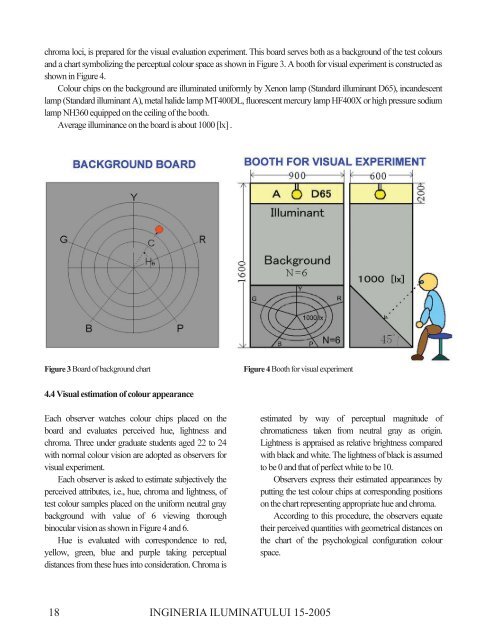Ingineria Iluminatului - Journal of Lighting Engineering - Prof. Florin ...
Ingineria Iluminatului - Journal of Lighting Engineering - Prof. Florin ...
Ingineria Iluminatului - Journal of Lighting Engineering - Prof. Florin ...
You also want an ePaper? Increase the reach of your titles
YUMPU automatically turns print PDFs into web optimized ePapers that Google loves.
chroma loci, is prepared for the visual evaluation experiment. This board serves both as a background <strong>of</strong> the test colours<br />
and a chart symbolizing the perceptual colour space as shown in Figure 3. A booth for visual experiment is constructed as<br />
shown in Figure 4.<br />
Colour chips on the background are illuminated uniformly by Xenon lamp (Standard illuminant D65), incandescent<br />
lamp (Standard illuminant A), metal halide lamp MT400DL, fluorescent mercury lamp HF400X or high pressure sodium<br />
lamp NH360 equipped on the ceiling <strong>of</strong> the booth.<br />
Average illuminance on the board is about 1000 [lx] .<br />
Figure 3 Board <strong>of</strong> background chart Figure 4 Booth for visual experiment<br />
4.4 Visual estimation <strong>of</strong> colour appearance<br />
Each observer watches colour chips placed on the<br />
board and evaluates perceived hue, lightness and<br />
chroma. Three under graduate students aged 22 to 24<br />
with normal colour vision are adopted as observers for<br />
visual experiment.<br />
Each observer is asked to estimate subjectively the<br />
perceived attributes, i.e., hue, chroma and lightness, <strong>of</strong><br />
test colour samples placed on the uniform neutral gray<br />
background with value <strong>of</strong> 6 viewing thorough<br />
binocular vision as shown in Figure 4 and 6.<br />
Hue is evaluated with correspondence to red,<br />
yellow, green, blue and purple taking perceptual<br />
distances from these hues into consideration. Chroma is<br />
18<br />
INGINERIA ILUMINATULUI 15-2005<br />
estimated by way <strong>of</strong> perceptual magnitude <strong>of</strong><br />
chromaticness taken from neutral gray as origin.<br />
Lightness is appraised as relative brightness compared<br />
with black and white. The lightness <strong>of</strong> black is assumed<br />
to be 0 and that <strong>of</strong> perfect white to be 10.<br />
Observers express their estimated appearances by<br />
putting the test colour chips at corresponding positions<br />
on the chart representing appropriate hue and chroma.<br />
According to this procedure, the observers equate<br />
their perceived quantities with geometrical distances on<br />
the chart <strong>of</strong> the psychological configuration colour<br />
space.
















